- 1Environment, Health and Safety, Leuven, IMEC, Leuven, Belgium
- 2PAML-LN, IICT, Bulgarian Academy of Sciences, Sofia, Bulgaria
Introduction: The SIR (Susceptible-Infected-Recovered) model is one of the simplest and most widely used frameworks for understanding epidemic outbreaks.
Methods: A second-order dynamical system for the R variable is formulated using an infinite exponential series expansion, and a recursion relation is established between the series coefficients. A numerical approximation scheme for the R variable is also developed.
Results: The proposed numerical method is compared to a double exponential (DE) nonlinear approximate analytic solution, which reveals two coupled timescales: a relaxation timescale, determined by the ratio of the model’s time constants, and an excitation timescale, dictated by the population size. The DE solution is applied to estimate model parameters for a well-known epidemiological dataset—the boarding school flu outbreak.
Discussion: From a theoretical standpoint, the primary contribution of this work is the derivation of an infinite exponential, Dirichlet, series for the model variables. Truncating the series yields a finite approximation, known as a Prony series, which can be interpreted as a sequence of coupled exponential relaxation processes, each with a distinct timescale. This apparent complexity can be approximated well by the DE solution, which appears to be of main practical interest.
1 Introduction
Epidemic models have undergone steady development during the last 100 years. The SIR model, short for Susceptible-Infectious-Recovered model, is a fundamental framework in epidemiology used to describe the spread of infectious diseases within a population. Developed by Kermack and McKendrick in the early 20th century [1], the SIR model categorizes individuals into three compartments: Susceptible (S), those who can contract the disease; Infectious (I), those who have contracted the disease and can transmit it to others; and Recovered (R), those who have recovered from the disease and are assumed to be immune. The SIR model is used to model epidemic outbreaks (see the monograph of Martcheva [2] or [3]). By modeling the rates of transition between these compartments, the SIR model provides insights into the dynamics of epidemic outbreaks, helping predict the spread and eventual decline of infections. It should be noted that the original model derived by Kermack and McKendrick was formulated in terms of convolution integrals, while the more popular form used in the present literature is actually only its simplified case.
The SIR model is one of the simplest examples of dynamical system with a positive and a negative feedback loops. That is, the model features competing excitation and relaxation processes. The SIR model has an universal applicability in epidemiology as well as in different areas of social sciences – information spread in social networks, behavior and influence adoption, social movements and protests, etc. [5]. For example, in social networks individuals in the network can be categorized as susceptible (not yet informed), infectious (spreading the information), or recovered (informed but no longer spreading).
Kendall [6] derived the parametric solution for the
The main contribution of the present manuscript is to give an analytical solution of the SIR model as infinite exponential (i.e. general Dirichlet) series. Upon truncation the solution produces a finite Prony series, which can be of some practical interest. The Prony series expression is a mathematical tool used primarily to model viscoelastic materials, capturing their time-dependent behavior through a sum of exponential terms. Each term represents a distinct relaxation process with specific relaxation times and moduli. This series is particularly useful in engineering and material science for simulating and predicting the performance of polymers, rubbers, and biological tissues. The article further derives the double exponential approximate analytical solution of the SIR model. Finally, the third contribution of the article is a Newtonian iteration schema for the R-variable.
2 Preliminaries of the SIR model
The contemporary formulation of the model can be found in [2]. The SIR model is built on several simplifying assumptions [4]. The dynamical formulation of the model comprises a set of three ordinary differential equations ODEs Equations 1–3:
By construction, the model assumes a constant overall population
2.1 On two useful special functions
The theory of the SIR model is closely related to two special functions – the Lambert W function and the Wright’s
The Lambert W function is defined implicitly by the functional equation
and as such is the simplest example of a root of an exponential polynomial. Properties of the function are surveyed in [14]. It is particularly useful in solving equations where the variable appears both in the base and the exponent, and it finds applications in various fields, such as combinatorics, physics, biochemistry, and complex analysis. Applications in physics include the Wien’s displacement law; in biochemistry – the Michaelis-Menten kinetic equation, etc. In general, the W function is multivalued. Analytically continued on the complex plane, the function has a countably infinite number of complex-valued branches. The real-valued branches are two. The principal branch is conventionally denoted by
The Lambert’s function is a simple example of a function which is non-Liouvillian – it can not be expressed by a finite composition of elementary functions or their integrals [15].
Useful identities are Equations 5–9:
Furthermore, the Lambert function obeys the differential equation
The point
where
The Wright’s Omega function is closely related to the W function [16]. Corless and Jeffrey [16] define the function as
The
This equation arises in biochemistry as the Michaelis-Menten enzyme kinetic equation. The present work uses different convention
3 The parametric solution of the SIR model
The common formulation of the SIR model employs two time constants. The non-dimensionalization of the model can eliminate one of the constants. In the present formulation, time will be re-scaled as
This reformulation simplifies some of the resulting expressions. Observe that
This is related to the effective reproduction number if only susceptible individuals are present before the outbreak. The parametric solution takes
The parametric solution can be computed as
where the domain of s is
The solution is given by the Lambert function branches
The proof is by direct substitution
We also observe that
For the i-variable, the solution can be computed by substitution from Equation 17.
This equation involves quadrature of only elementary functions, which are present in any numerical package.
Finally,
From the above we see that
One of the roots of Equation 20 by inspection is
The proof is obtained by a direct substitution:
We also observe that
The above formulation allows one to clearly split the temporal axis in terms of the branches of the Lambert function. The special choice of the origin allows one to discuss predictive (falling) and retrodictive (rising) solutions, expressed by the i-variable. The predictive solution corresponds with the positive principal branch of the Lambert function, while the retrodictive solution corresponds with the non-principal branch.
4 Second-order dynamical systems for the SIR model
The SIR model can be formulated also as several equivalent second-order non-linear dynamical systems for the different variables. The readers are directed to the original results in [7, 12].
4.1 A dynamical system for the i-variable
The following results are stated and proofs are repeated for convenience.
Proposition 1. The SIR system is reducible to the non-linear differential equation for the i-variable:
or the system
Proof. from the conservation law
The system admits elementary solutions
4.2 A dynamical system for the s-variable
An equivalent second-order system for the s-variable was deduced in [7].
Proposition 2. The SIR system is reducible to the non-linear differential equation for the s-variable
or the system
Proof.
On the other hand,
Substitution gives
from where the result follows.
4.3 A dynamical system for the r-variable
Finally, the r-variable can be represented by the following system.
Proposition 3. The SIR system is reducible to the second order non-linear differential equation for the r-variable
or the dynamical system
Proof. differentiating Equation 15 yields
which possesses an elementary solution as an equation of state:
We use the fixed-point condition
where N is the population size from where the result follows.
Obviously, the presented list of dynamical systems Equations 22–29 is non-exhaustive since for any composition of the model variables one could derive a corresponding dynamical system.
The dynamical system described in Proposition 3 is illustrated in Figure 1. The figure exhibits the vector field given by Equations 28, 29 and features one particular trajectory, integrated numerically with the Runge-Kutta fourth order method. The above formulations indicate three potential lines of attack for obtaining a globally convergent series solution. If the system for the r-variable is employed one needs to compute the exponential of a series followed by multiplication with the original series. This seems the least computationally complex approach and it will be pursued in the present paper.
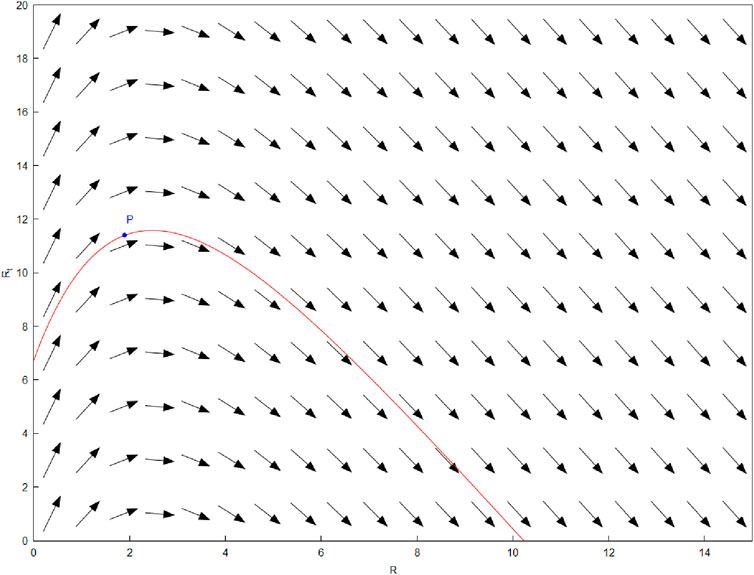
Figure 1. The dynamic system for the r-variable, Equation 28. Parameter values –
5 Properties of the state equations
To simplify presentation we further re-scale both time and population variables as
and differentiation with respect to
where Equation 30 follow from Equation 31, while Equation 32 follows from the construction of SIR model – i.e. the number conservation first integral. Therefore, at positive infinity
so that
by Equation 5. While for
hold. These are limiting behaviors which should hold for any approximation of practical interest.
Furthermore, the outbreak peak is given by the triple:
under the obvious conditions
Furthermore, the
This equation is solvable with the help of the Lambert’s W function as
Therefore,
where the principal branch is taken for
in accordance with the first integral. The last Equations 36, 37 can be expressed concisely by the
with a similar convention for the branches.
6 Exponential series solution
6.1 Predictive series
First, we will look for a solution, approximating the r-variable on the positive real line. The asymptotic analysis indicates that an approximation may be achievable using a general Dirichlet series of the form:
where
The formal exponent of the Dirichlet series is another general Dirichlet series
where the coefficients
The complete Bell polynomials in turn can be readily calculated from the determinant
The first few polynomials can be listed as
We substitute the above expressions in Equation 27, which obtains the form
Observe that reversing time direction will result in a change of sign of the right-hand side of the equation. Therefore, it will be sufficient to determine the coefficients only for the positive time direction. The resulting expression is
Since we work with formal infinite series one can apply the Cauchy product formula. Therefore, we obtain the equation
Equating the exponents results in the following recursion dependence between the coefficients:
The first terms of the recursion are
Therefore, for the base exponent
where we have recognized the appearance of the Newton’s binomial coefficients and
The first few coefficients of the series can be readily computed as
Substituting the value of q produces an equivalent form of the sequence as
The above procedure is essentially algorithmic and easily amenable to programming in a computer algebra system. The procedure leaves the coefficient
where now
Furthermore, observe that
6.2 Retrodictive series
In this section we revert the time direction and look for series of the form
which asymptotically approaches
Therefore,
Therefore,
This results in coefficients
Therefore, as before we can set
In summary, as before we can determine the solution up to translation in time.
6.3 Peak value parametrization - predictive series
In this section, we use the peak parametrization where
where we also denote the infinite sum
The Lambert function identity
The same development procedure produces the recursion
where now
The coefficients are still given by Equation 42 but expressed in terms of A can be read off as
while the base exponent is
6.4 Peak value parametrization – retrodictive series
We start from the equation
where
So it follows that
where
In summary, the presented approach is manifestly time-asymmetric due to the properties of the equivalent dynamical system for the r-variable.
6.5 The i-variable
The other observable of the model is the
Therefore, by substitution
For the value at
and finally
For the case
Then
so that the series agree.
The asymptotes at infinity are verified by direct substitution
6.6 The s-variable
The series for the s-variable can be determined from the state equations as
and
7 Non-linear approximation procedure
Since the SIR solution is non-singular everywhere in
7.1 The double-exponential approximate solution
Starting from the 0th order approximation
can be formulated as a functional integral equation to be approximated by DJM.
From there the first order approximation for the i-variable becomes the double exponential function
The corresponding solution for
where we take the non-principal branch
Therefore, we can claim:
Proposition 4. The double-exponential, approximate analytic solution of the SIR model is given by Equations 44–46.
The advantage of this formulation is that it respects the population size integral as well as the fixed points of the dynamical system.
On the other hand, formulated through the
also holds. However, iterating this system will not lead to global convergence towards the analytical solution since
To link this approach with the Prony approximation one observes that
which has the form of a general Dirichlet series and can be readily truncated into Prony approximation. From this analysis one can interpret
7.2 The
DJM method can be further applied as follows. The second iteration of the DJM method results in a
where
This is another non-elementary integral which can be readily computed by quadratures as it involves one of the common special functions.
8 Newtonian approximation of the r-variable
The R-variable can be computed by numerical inversion of Equation 19. A suitable algorithm to do so is the Newton-Raphson approximation based on the double-exponential formula. An approximation schema can be derived for an input
Let
Then the iteration schema is
Therefore,
where we take the non-principal branch
is bounded–that is, wherever the initial value
since
Furthermore, suppose that the value of the denominator
since
Validation data on the approach are included in the Supplementary Material.
9 Numerical results
The asymptotics of the i-variable are compared with the parametric solution in Figure 2. Figure 3 demonstrates the approximate double-exponential SIR model. The parametric solution for the
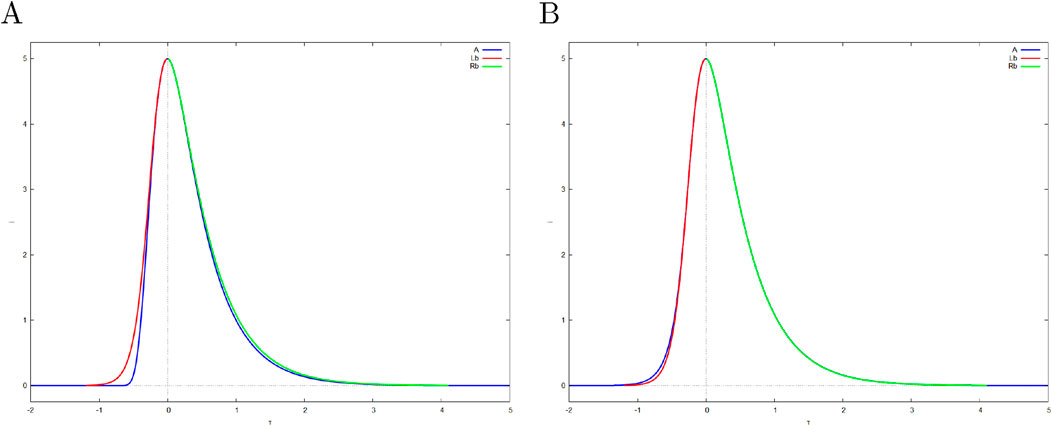
Figure 2. Parametric and asymptotic solutions for the incidence variable
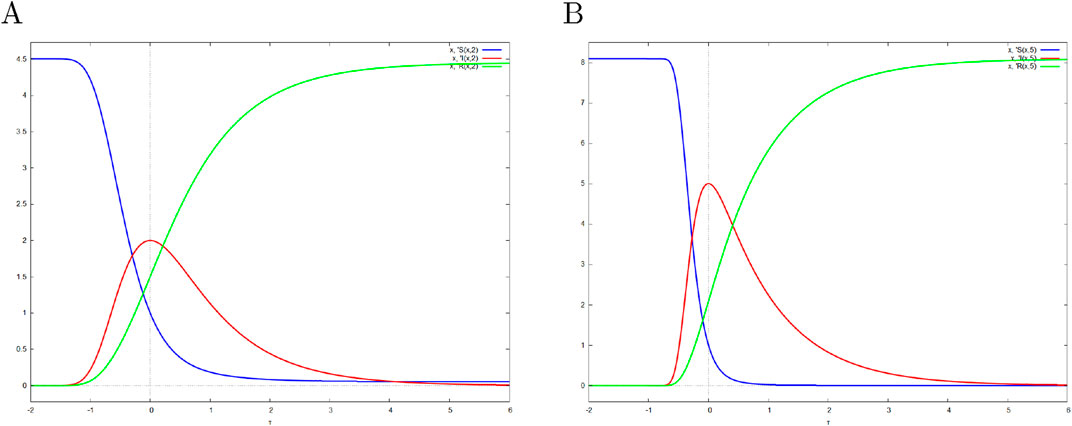
Figure 3. Double-exponential approximation of the SIR model. S, I, R denote the s(t), i(t) and r(t) first order approximations, respectively. (A)
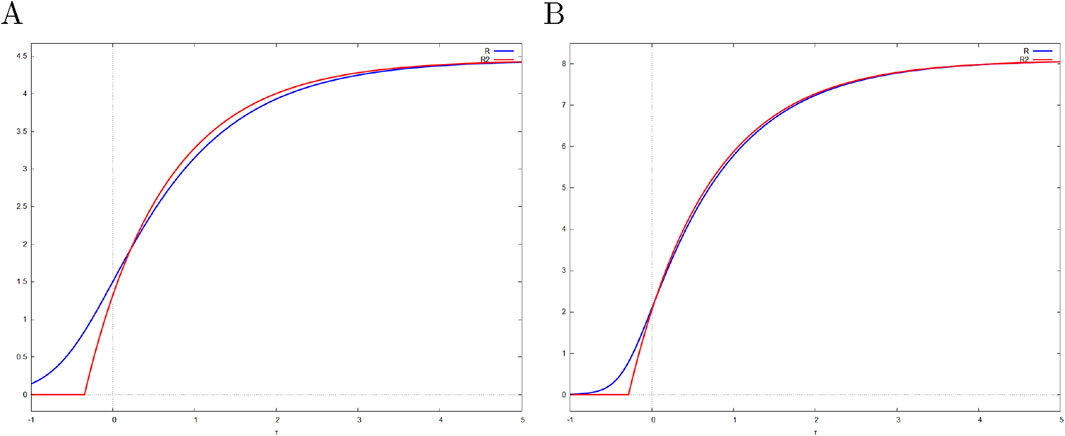
Figure 4. 3-term Prony predictive approximation of the r-variable. ilambint61 denotes the parametric solution, R3 denotes 3-term Prony approximation. (A)

Figure 5. Approximation of the r-variable. R denotes the parametric solution, R1 denotes the approximate solution, given by Equation 45. (A)
10 A case study in epidemiology
The approach was applied to the boarding school flu dataset. The influenza data are tabulated in [2]. The table is reproduced as a Supplementary Material. The parametric fitting was conducted using a least-squares constrained optimization algorithm. The least-squares constrained optimization was preformed using the
for the observed cumulative incidence
where
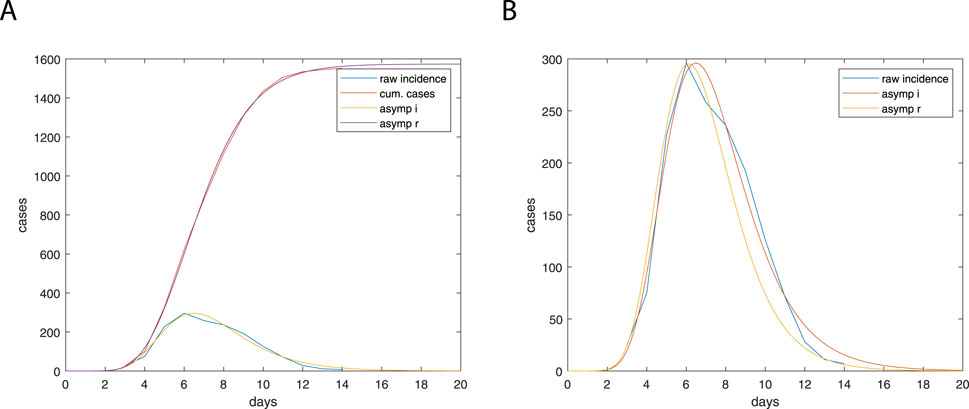
Figure 6. Asymptotic fitting of reported cases. (A) Comparison between the raw data and fitted curves for the infected (“asymp i”) and recovered populations (“asymp r”); (B) Incidence data compared to fitted curves. Parameters from Table 1 were used to compute the incidence curves, “asymp i” – fitting for I, “asymp r” – fitting for R.
11 Discussion and conclusion
The contributions of the present article are three fold. On the first place, the article presents an infinite exponential series solutions, converging on the real half-plane. The presented exponential series explicitly characterizes the non-elementary
The time-asymmetry of the dynamical system for the R-variable dictates the appearance of the very different forms of the exponential series. Most likely this phenomenon will hold also in other models derived from SIR, such as SEIR and SIRD.
On the second place, a new numerical approximation schema was derived for the R-variable. To obtain convergence to the correct branch it is crucial to start from an initial approximation, which is close to the exact solution.
Finally, the non-linear approximation produces produces and approximate analytic solution which matches globally the previously-obtained parametric solution of the SIR system. The global solutions are represented as compositions of Lambert W function with elementary ones, which furthers the utility of the Lambert W and the closely related
Data availability statement
The original contributions presented in the study are included in the article/Supplementary Material, further inquiries can be directed to the corresponding author.
Author contributions
DP: Writing–original draft, Writing–review and editing.
Funding
The author(s) declare that no financial support was received for the research, authorship, and/or publication of this article.
Conflict of interest
Author DP was employed by IMEC.
Publisher’s note
All claims expressed in this article are solely those of the authors and do not necessarily represent those of their affiliated organizations, or those of the publisher, the editors and the reviewers. Any product that may be evaluated in this article, or claim that may be made by its manufacturer, is not guaranteed or endorsed by the publisher.
Supplementary material
The Supplementary Material for this article can be found online at: https://www.frontiersin.org/articles/10.3389/fphy.2024.1469663/full#supplementary-material
References
1. Kermack WO, McKendrick AG. A contribution to the mathematical theory of epidemics. Proc R Soc Lond Ser A, Containing Pap a Math Phys Character (1927) 115:700–21. doi:10.1098/rspa.1927.0118
2. Martcheva M. An introduction to mathematical epidemiology. Springer US (2015). doi:10.1007/978-1-4899-7612-3
3. Hethcote HW. The mathematics of infectious diseases. SIAM Rev (2000) 42:599–653. doi:10.1137/s0036144500371907
4. Tang L, Zhou Y, Wang L, Purkayastha S, Zhang L, He J, et al. A review of multi-compartment infectious disease models. International Statistical Review 88 (2020) 462–513. doi:10.1111/insr.12402
5. Funk S, Gilad E, Watkins C, Jansen VAA. The spread of awareness and its impact on epidemic outbreaks. Proc Natl Acad Sci (2009) 106:6872–7. doi:10.1073/pnas.0810762106
6. Kendall D. Deterministic and stochastic epidemics in closed populations. Berkeley Symp Math Stat Probab (1956) 4:149–65. doi:10.1525/9780520350717-011
7. Harko T, Lobo FSN, Mak MK. Exact analytical solutions of the susceptible-infected-recovered (SIR) epidemic model and of the SIR model with equal death and birth rates. Appl Mathematics Comput (2014) 236:184–94. doi:10.1016/j.amc.2014.03.030
8. Barlow NS, Weinstein SJ. Accurate closed-form solution of the SIR epidemic model. Physica D: Nonlinear Phenomena (2020) 408:132540. doi:10.1016/j.physd.2020.132540
9. Kröger M, Schlickeiser R. Analytical solution of the SIR-model for the temporal evolution of epidemics. Part A: time-independent reproduction factor. J Phys A: Math Theor (2020) 53:505601. doi:10.1088/1751-8121/abc65d
10. Prodanov D. Analytical parameter estimation of the SIR epidemic model. applications to the COVID-19 pandemic. Entropy (Basel, Switzerland) (2020) 23:59. doi:10.3390/e23010059
11. Prodanov D. Comments on some analytical and numerical aspects of the SIR model. Appl Math Model (2021) 95:236–43. doi:10.1016/j.apm.2021.02.004
12. Kudryashov NA, Chmykhov MA, Vigdorowitsch M. Analytical features of the SIR model and their applications to COVID-19. Appl Math Model (2021) 90:466–73. doi:10.1016/j.apm.2020.08.057
13. Bougoffa L, Bougouffa S, Khanfer A. Approximate and parametric solutions to sir epidemic model. Axioms (2024) 13:201. doi:10.3390/axioms13030201
14. Corless RM, Gonnet GH, Hare DEG, Jeffrey DJ, Knuth DE. On the Lambert W function. Adv Comput Mathematics (1996) 5:329–59. doi:10.1007/bf02124750
15. Bronstein M, Corless RM, Davenport JH, Jeffrey DJ. Algebraic properties of the Lambert W function from a result of rosenlicht and of liouville. Integral Transforms Spec Functions (2008) 19:709–12. doi:10.1080/10652460802332342
16. Corless RM, Jeffrey DJ. The Wright Omega function. In: Lecture notes in computer science. Berlin Heidelberg: Springer (2002). p. 76–89. doi:10.1007/3-540-45470-5_10
17. Daftardar-Gejji V, Jafari H. An iterative method for solving nonlinear functional equations. J Math Anal Appl (2006) 316:753–63. doi:10.1016/j.jmaa.2005.05.009
18. Piessens R, Doncker-Kapenga E, Überhuber CW, Kahaner DK. Quadpack. Springer Berlin Heidelberg (1983). doi:10.1007/978-3-642-61786-7
19. [Dataset] Errico D. MATLAB Central Exchange (2012). Available from: https://www.mathworks.com/matlabcentral/fileexchange/8277-fminsearchbnd-fminsearchcon (Accessed July 29 2019).
Keywords: SIR model, Lambert W function, Wright Omega function, asymptotic analysis, incomplete gamma function
Citation: Prodanov D (2024) Exponential series approximation of the SIR epidemiological model. Front. Phys. 12:1469663. doi: 10.3389/fphy.2024.1469663
Received: 24 July 2024; Accepted: 26 August 2024;
Published: 17 October 2024.
Edited by:
Alessandro Vezzani, National Research Council (CNR), ItalyReviewed by:
Giulia De Meijere, Tampere University, FinlandPierluigi Vellucci, Roma Tre University, Italy
Copyright © 2024 Prodanov. This is an open-access article distributed under the terms of the Creative Commons Attribution License (CC BY). The use, distribution or reproduction in other forums is permitted, provided the original author(s) and the copyright owner(s) are credited and that the original publication in this journal is cited, in accordance with accepted academic practice. No use, distribution or reproduction is permitted which does not comply with these terms.
*Correspondence: Dimiter Prodanov, ZGltaXRlci5wcm9kYW5vdkBpbWVjLmJl
 Dimiter Prodanov
Dimiter Prodanov